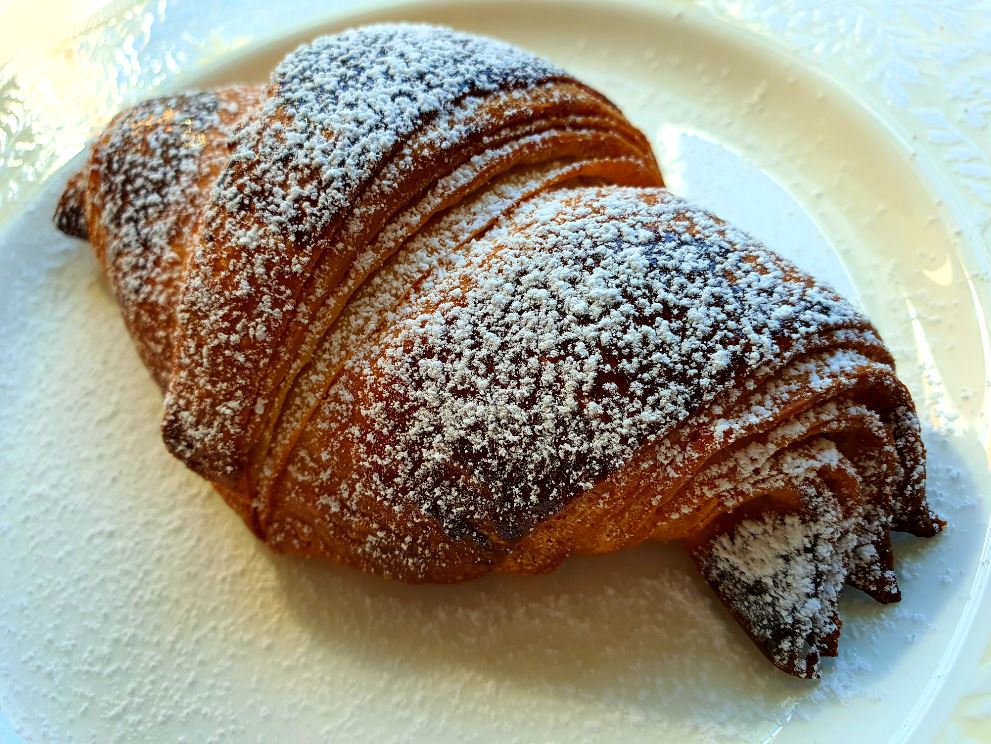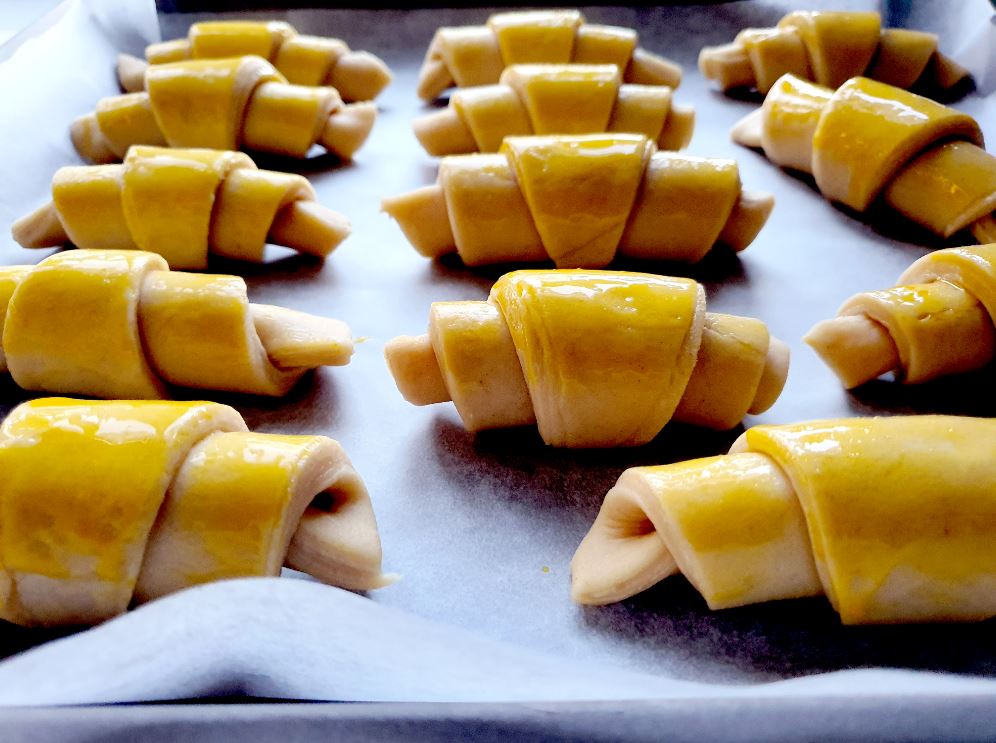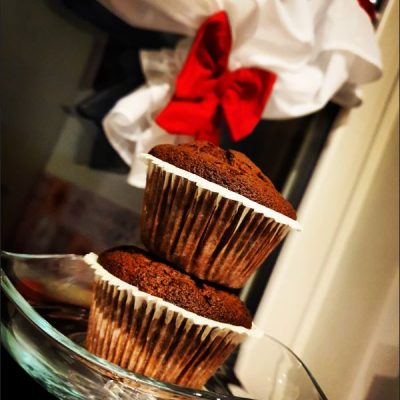Ingredients
-
300 g All-Purpose Flour - Farina 0
-
200 g Bread Flour - Farina Manitoba
-
80 g White Sugar - Zucchero
-
15 g Fresh brewer's yeast - Lievito di birra fresco
-
300 ml Milk - Latte
-
a pinch - un pizzico Salt - Sale
-
250 g Butter - Burro
-
1 Yolk - Rosso d'uovo
Directions
How about a nice croissant for breakfast today?
The croissant comes from the Viennese kipfel, but it is not an Italian “cornetto”! The difference lies in the dough. Despite they are close relatives, they aren’t the same thing. In fact, the croissant dough is more neutral, because it does not include eggs inside, unlike his cousin, the “cornetto”. Its consistency is lighter. In addition, there is less sugar so, if you prefer, it can also be stuffed with meats and cheeses for a savory breakfast.
What do you think? Do you prefer the croissant or the “cornetto”? There would also be the brioche option, but I’ll talk about those in the next episode! Stay tuned
Che ne dite di un bel croissant per la colazione di oggi?
Il croissant deriva dal kipfel viennese, ma non è un cornetto! La differenza risiede nell’impasto. Nonostante siano vicini parenti non solo la stessa cosa. Infatti l’impasto del croissant è più neutro, perché non prevede uova all’interno, a differenza del cugino cornetto. La sua consistenza è più sfogliata e leggera in confronto al cornetto all’italiana. Inoltre c’è meno zucchero, quindi volendo può essere farcito anche con salumi e formaggi per una colazione salata.
E voi che ne pensate? Preferite il cornetto o il croissant? Ci sarebbe anche l’opzione brioche, ma di quelle ve ne parlerò alla prossima puntata! Stay tuned
Steps
|
1
Done
|
Mix the sifted flours, sugar, yeast (dissolved in a little milk), and 100 grams of softened butter in a stand mixer (for about 10 minutes, until the dough remains attached to the hook), adding the warm milk a little at a time. If you don't have a stand mixer, knead by hand! Form a ball of dough and let it rise for an hour in a bowl covered with plastic wrap. Impastare nella planetaria (per circa 10 minuti, finché l’impasto non resta attaccato al gancio) le farine setacciate, lo zucchero, il lievito sciolto in un pochino di latte e 100 grammi di burro ammorbidito a fiocchetti, aggiungendo a filo il latto leggermente tiepido. Se non avete la planetaria impastate a mano con tanto olio di gomito! Formare una palla di impasto e mettere a lievitare per un’ora in una ciotola coperta da pellicola. |
|
2
Done
|
Transfer the dough onto a floured pastry board, press it to deflate it, and spread it in a rectangle on a baking tray lined with parchment paper and cover with plastic wrap. Put in the freezer for 20 minutes, turn the dough and freeze it for another 25 minutes. Roll out the dough into a rectangle (half a centimeter thick). Trasferire l’impasto su una spianatoia infarinata, premerlo per sgonfiarlo e stenderlo in un rettangolo su una teglia rivestita con carta forno. Coprire con pellicola. Mettere in freezer per 20 minuti, girare l’impasto e farlo congelare altri 25 minuti. Stendere la sfoglia in un rettangolo di mezzo centimetro di spessore. |
|
3
Done
|
Roll out the remaining 150 g of butter with a rolling pin, between two sheets of parchment paper, to form a rectangle of the same width as the pasta sheet. Stendere i restanti 150 gr di burro con un mattarello, tra due fogli di carta da forno, in maniera tale da formare un rettangolo della stessa larghezza della sfoglia di pasta. |
|
4
Done
|
Remove from the fridge and roll out with a rolling pin to obtain a rectangle (half a centimeter thick). Now, fold the dough into a wallet, overlapping the two edges. Put back in the fridge for 30 minutes wrapped in plastic wrap. Togliere da frigo e stendere con il mattarello per ottenere un rettangolo di mezzo centimetro di spessore. A questo punto ripiegare l’impasto a portafoglio, sovrapponendo i due lembi. Mettere di nuovo in frigo per 30 minuti avvolto da pellicola. |
|
5
Done
|
Roll out the dough into a rectangle approximately 40x56 centimeters and a half-centimeter thick. Stendere la pasta in un rettangolo di circa 40x56 centimetri e mezzo centimetro di spessore. |
|
6
Done
|
Roll the dough starting from the base in order to obtain compact croissants. Transfer to a baking tray lined with parchment paper, with the tip pointing downwards, brushes with the yolk and… Arrotolare la pasta partendo dalla base in maniera tale da ottenere dei cornetti compatti. Trasferire su una teglia rivestita con carta forno, con la punta rivolta verso il basso, spennellare con il tuorlo e… |
|
7
Done
|
Option 1: leave to rise for 2 hours in a warm place. Brush again and bake in a preheated oven at 180 ° C (fan oven) for 20 minutes. Opzione 1: lasciare lievitare 2 ore in un luogo tiepido. Spennellare nuovamente e cuocere in forno preriscaldato a 180°C (forno ventilato) per 20 minuti. |















